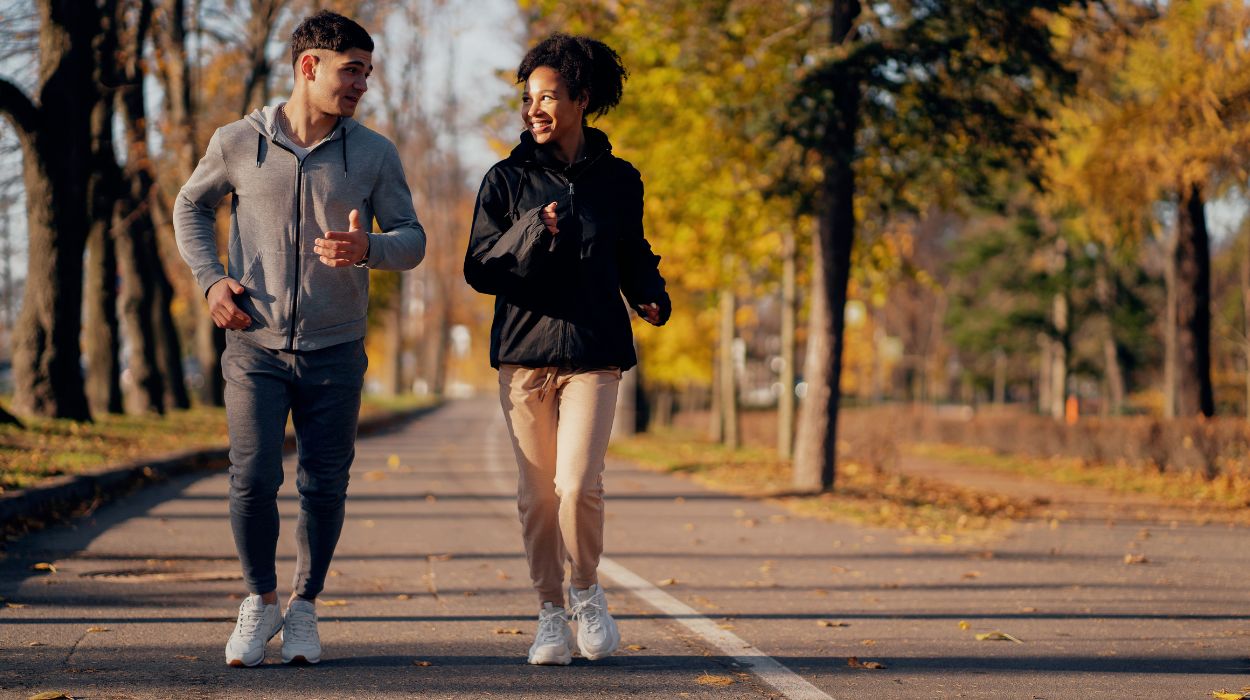
Whether you’re a novice or an experienced athlete, running a 5K is probably part of your exercise goal. It offers an achievable distance that continues to be popular among all levels of fitness.
At 5000 meters or 3.1 miles, the 5K race is one of the shortest race distances that you can perform. It’s great for improving your fitness, working on performance, or as a social event to enjoy.
Whatever your exercise goals are, knowing your average 5K time can prove useful. It gives you a benchmark to focus on and helps you to understand the factors that influence performance.
In this article, we discuss how long a 5K may take by age and gender. We explain the factors that influence your 5K performance and improve speed.
Whether you’re performing the 5K alongside a dumbbell leg workout or by itself, this article will provide useful information.
5K Run Average Time
The average 5K time according to gender and ability level can be summarized as follows:
- Novice to elite male runners – 34:50 to 19:26 minutes.
- Novice to elite female tuners – 38:80 to 22:67 minutes.
As both sexes increase in age, their average 5K time tends to go up.
The tables below can be used as a reference guide to work out your expected 5K time. Other factors that may influence performance include height, running ground, gait, and fitness level.
Average 5K Time By Age

The running standards below are based on well-known statistics from large running databases. The standards have been worked out from reports of 5K finishing times.
The average time in minutes by age has been organized according to skill.
| Age | Beginner (Faster than 5% of runners. They have been training for at least one month) | Intermediate (Faster than 20% of runners. They have been training for at least six months) | Advanced (Faster than 80% of runners. They have been training for at least two years) | Elite (Faster than 95% of runners. They have been training seriously for over five years) |
| 10 to 14 | 39:34 | 28:44 | 25:18 | 22:64 |
| 15 to 19 | 34:75 | 29:27 | 20:70 | 19:84 |
| 20 to 24 | 33:28 | 24:19 | 21:24 | 18:94 |
| 25 to 29 | 33:28 | 24:19 | 21:24 | 18:94 |
| 30 to 34 | 33:28 | 24:20 | 21:24 | 18:94 |
| 35 to 39 | 33:50 | 24:35 | 21:67 | 19:07 |
| 40 to 44 | 34:67 | 24:96 | 21:94 | 19:79 |
| 45 to 49 | 35:84 | 25:93 | 22:84 | 20:63 |
| 50 to 54 | 37.24 | 27.25 | 23.88 | 21.60 |
| 55 to 59 | 39.36 | 28.47 | 25.20 | 22.46 |
| 60 to 64 | 41.41 | 29.98 | 26.40 | 23.78 |
| 65 to 69 | 43.80 | 31.80 | 27.90 | 24.98 |
In the table above, you can see the expected times according to ability level and age. We’ve used age groups from 10 to 69 with four classes of runners from novice to elite.
To use the table, decide your skill according to experience and read down to find your age group. The stated time is your expected 5K time according to the records of others.
10 To 29
As a runner at any level, the average times tend to be slower at a younger age. Once in your late twenties and early thirties, the time increases except for the high-level runners with more running experience.
Many hit their peak performance between 20 to 30 years old.
30 To 49
At 30 to 49 years old, time across all fitnesses increases. This is probably due to age-related declines in muscle mass, energy levels, and mobility.
Each of these influences the running economy which then affects 5K performance.[1]
50 To 69
At 50 to 69 years old, the time to complete a 5K further increases for all capabilities. The differences in times between the 10 to 14 and 65 to 69 age groups are as follows:
- Beginner runners: + 4:46 minutes.
- Intermediate runners: + 3:36 minutes.
- Advanced runners: + 2:72 minutes.
- Elite runners: + 2:34 minutes.
As you can see above, those who are more fit tend to lose less time as aging. This could be because they can maintain their health and physical characteristics better during the aging process.
Average 5K Time By Gender

The table below shows the average time in minutes for a 5K according to gender and ability level. These times have been taken using age statistics from males and females from 10 to 69 years old.
| Beginner | Intermediate | Advanced | Elite | |
| Female | 38:80 | 28:55 | 25:24 | 22:67 |
| Male | 34:50 | 26:47 | 21:56 | 19:26 |
This gives you an example of your expected time.
To work out your own predicted time, decide your skill according to the guide and read down where appropriate. The table should be used as a guide and not an absolute value to aim for.
Gender Differences
Compared to males, females are slower across all levels.
This is likely due to hormonal differences[2] such as a lower level of testosterone. Physical causes may include a smaller stride length and lower muscle mass compared to males.
The biggest difference seems to be as a rookie runner, with a + 4:30 minute difference between the times depending on sex. At an elite level, the difference between genders is smaller at + 3:41 minutes between males and females.
Other Factors That Can Affect Your 5K Run Time
The tables above show the average 5K time by age and gender. Other factors that may be influencing your 5K run time have been listed below.
Height
The taller you are, the longer your legs tend to be. Longer legs tend to give you a bigger stride length, meaning you’ll take fewer steps to complete the 5K.
Those with a longer stride length require less ground contact time when running. This can influence your running speed[3] which can impact 5K performance.
Terrain
This refers to the physical features of the environment around you. For the 5K, this would be your running surface. Most people wonder if the terrain makes running bad for your knees rather than the effects on performance.
Different running surfaces can change your length. When running uphill, your step length is shorter, decreasing your length. With more steps needed to complete the same 5K distance, this impacts running times.[4]
Gait
This refers to the pattern of limb movement over a set distance. It includes your form, pace, and foot landing zone.
If your form is more efficient, you’ll use fewer steps to cover the 5K distance. Small changes in gait can influence performance.[5]
Fitness Level
With a better baseline, the 5K distance will place a smaller cardiorespiratory demand on your body. This will improve your running economy[6] which addresses the integration of a variety of systems. These include metabolic health, gait biomechanics, and neuromuscular feedback in running.
Tips To Run Faster
Running can be great for losing weight and improving fitness. It can also be used to make your butt bigger with regular performance.
Whether you’re performing a 5K or a half marathon, the advice below can be used to improve your 5K performance. Whether running or biking, some of the same information will apply.
Pace Yourself Correctly
Developing an awareness of your pace whilst running can take several races to perfect.
Aim to run the first four kilometers at a consistent pace, monitoring each kilometer and adjusting accordingly. This allows you to conserve energy for the final push during the final kilometer.
This may require several sessions. Knowing this can also help you determine how long to run on a treadmill or track during training.
Practice At The Target Race Pace
Your mind and body should have a good idea of what it’s like to run at a race pace. During training, break your race pace up into smaller intervals and progress accordingly.
When including this in your schedule, continue to adjust your schedule based on the previous race pace session.
Structure Your Training
If you perform the same sessions daily, your 5K performance will improve. However, this will be at a much slower pace compared to a structured training program.
More experienced runners tend to incorporate easy days and hard days into their training. Some sessions should consist of running at a maintenance pace whilst others should involve interval training. Make sure to also incorporate rest days each week as needed.
Monitor Your Cadence
Your running cadence[7] is the amount of steps you take per minute. Mid-level runners may use a metronome to practice their step rate when training. Aim to develop a consistent rate each kilometer.
Perform Strength Training
Improving your time for a 5K isn’t just about endurance training. Incorporating leg workouts into your routine can provide multiple health benefits.[8] These include improving your strength, power, mobility, and reaction time.
Alongside this, adding explosive plyometric training can help to work on running speed, power,[9] and stability. Add some circuit-based plyometric exercises at the end of your strength training sessions.
Monitor Your Running Form
Better running form leads to a better running economy. This in turn will help you run a 5K.
During training and competition, having an awareness of your running form will help to prevent any unnecessary deviations. Focus on keeping your body upright with your shoulders relaxed. Look ahead of you and toward the ground whilst keeping your arms at the side of your body.
Performing regular core workouts can help to improve posture and proprioception.
Warm Up Correctly
As should be the case before any exercise, make sure to warm up correctly before training and competition. Perform a short, sport-specific[10] warm-up.
Include lower back stretches as needed throughout your warm-up.
What Are The Current Fastest 5K Time Records?
The times below are the fastest 5K running times ever recorded[11] since the 5K race distance was invented. Most runners will train for their entire life without getting close to the times below.
Men
The current world record time in the men’s 5000-meter race is 12:35:36. Uganda’s Joshua Cheptegei did this on the 14th of August 2020 in Monaco, Frace. To put this into perspective, that would mean he ran at a pace of 2:47 minutes per kilometer.
As for the 5K road race, the best time for men is 12:49:60. Ethiopia’s Kenenisa Bekele did this on the 20th of February 2004 in Birmingham, UK.
Women
The current world record time in the women’s 5000-meter race is 14:00:21. This was accomplished by Ethiopia’s Gudaf Tsegay on the 17th of September 2023 in Orlando, America.
In terms of pace, this means that she ran at an average pace of approximately 2:80 minutes per kilometer.
As for the 5K road race, the world record time for women is 14:18:86. This was accomplished by Ethiopia’s Genzebe Dibaba on the 19th of February 2015 in Stockholm, Sweden.
Conclusion
Completing a 5K race can be a rewarding feat for many. Consider the times above as goals to work towards according to your age, gender, and skill.
Several other factors influence performance. These include your height, skill, terrain, and gait.
Consider using the advice above when looking to improve your 5K performance. These include taking a structured training approach, developing your race pace, and performing some strength and conditioning sessions.
Frequently Asked Questions
As a rookie runner, the expected 5K time would be 34:50 minutes for males and 38:80 minutes for females.
Running a 5K in 30 minutes is equivalent to running at a pace of 6 minutes per kilometer. At a mid-level and above, this would be expected in most groups.
What’s regarded as a fast 5K time would depend on your age, gender, and fitness. Any time in the high-level and elite categories would be considered fast for all age groups.
For a rookie, the average time is 38:80 minutes. For elite-level women, the average time is 22:67.
Resources
- Lara, B. and Juan José Salinero (2014). The relationship between age and running time in elite marathoners is U-shaped. Age, [online] 36(2), pp.1003–1008. doi:https://doi.org/10.1007/s11357-013-9614-z.
- Handelsman, D.J., Hirschberg, A.L. and Bermon, S. (2018). Circulating Testosterone as the Hormonal Basis of Sex Differences in Athletic Performance. Endocrine Reviews, [online] 39(5), pp.803–829. doi:https://doi.org/10.1210/er.2018-00020.
- Ardestani, M.M., Ferrigno, C., Mehran Moazen and Wimmer, M.A. (2016). From normal to fast walking: Impact of cadence and stride length on lower extremity joint moments. Gait & Posture, [online] 46, pp.118–125. doi:https://doi.org/10.1016/j.gaitpost.2016.02.005.
- Scott Nolan Drum, Ludwig Rappelt, Held, S. and Donath, L. (2023). Effects of Trail Running versus Road Running—Effects on Neuromuscular and Endurance Performance—A Two Arm Randomized Controlled Study. International Journal of Environmental Research and Public Health, [online] 20(5), pp.4501–4501. doi:https://doi.org/10.3390/ijerph20054501.
- Moran, M.F. and Wager, J.C. (2020). Influence of Gait Retraining on Running Economy: A Review and Potential Applications. Strength and Conditioning Journal, [online] 42(1), pp.12–23. doi:https://doi.org/10.1519/ssc.0000000000000511.
- Barnes, K.R. and Kilding, A.E. (2015). Running economy: measurement, norms, and determining factors. Sports Medicine – Open, [online] 1(1). doi:https://doi.org/10.1186/s40798-015-0007-y.
- Musgjerd, T., Anason, J., Rutherford, D. and Kernozek, T.W. (2021). Effect of Increasing Running Cadence on Peak Impact Force in an Outdoor Environment. The International journal of sports physical therapy, [online] 16(4). doi:https://doi.org/10.26603/001c.25166.
- Prieto-González, P. and Sedlacek, J. (2022). Effects of Running-Specific Strength Training, Endurance Training, and Concurrent Training on Recreational Endurance Athletes’ Performance and Selected Anthropometric Parameters. International Journal of Environmental Research and Public Health, [online] 19(17), pp.10773–10773. doi:https://doi.org/10.3390/ijerph191710773.
- Davies, G., Riemann, B.L. and Manske, R. (2015). CURRENT CONCEPTS OF PLYOMETRIC EXERCISE. International journal of sports physical therapy, [online] 10(6), pp.760–86. Available at: https://www.ncbi.nlm.nih.gov/pmc/articles/PMC4637913/.
- Johannes, R., Tormod Vatten and Dianne, E. (2017). Effects of Short or Long Warm-up on Intermediate Running Performance. The Journal of Strength and Conditioning Research, [online] 31(1), pp.37–44. doi:https://doi.org/10.1519/jsc.0000000000001489.
- worldathletics.org. (2023). World Athletics |. [online] Available at: https://worldathletics.org/records/by-category/world-records.




